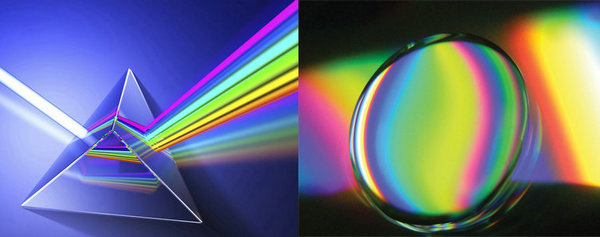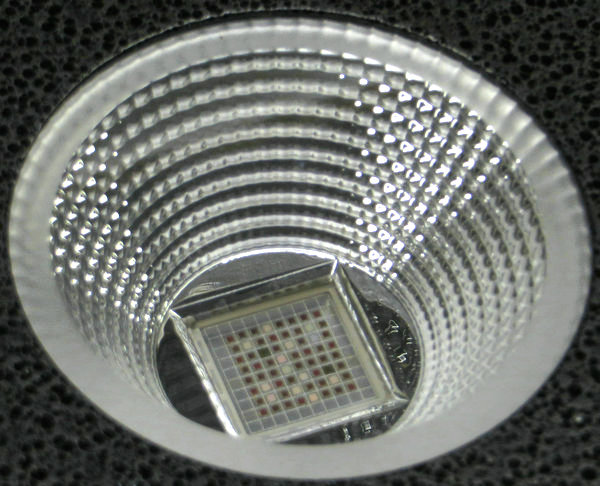There are many kinds of LED grow lights in the markets, but generally speaking, lens and reflector are mostly applied in the processing of light, they have different angles such as 70°, 90°and 110°, however, due to their different processing of light of different wavelength, there is also a difference in the light efficiency in terms of wavelength, loss of light, etc.

As we knew that artificial light by LED is able to make precise specific light for plant both in germination and blooming stage, but it is based on the fact that the specific color of light should be fully transmitted, if the wavelength of light changed, the effect of specific color of light to the plant will be much affected, although it is not easy to be detected by human eyes.
The lens has basic two functions of processing of light: Light-gathering and Refraction, In most cases, people are focusing more on the light gathering of lens, and the fact also shows that lens did a good job in light gathering, the light is concentrated in a cluster in its transmission, and with different angle of lens, we are able to have different beam angles of light, which is important to the light distribution and hence coverage area, however, during the light transmission through lens, the light is only transmitted in a single direction, so if the light sources is by COB, then color-mixing of light will be more weak than reflector which always supports multi-reflection by its unique reflection dots; However, there is a big problem coming from the structure of lens, as its unique structure also creates a lot of refraction for each light transmitted through lens, it is “refraction” as below image.

There are many kinds of LED grow lights in the markets, but generally speaking, lens and reflector are mostly applied in the processing of light, they have different angles such as 70°, 90°and 110°, however, due to their different processing of light of different wavelength, there is also a difference in the light efficiency in terms of wavelength, loss of light, etc.

Lens changes the wavelength of light
As we knew that artificial light by LED is able to make precise specific light for plant both in germination and blooming stage, but it is based on the fact that the specific color of light should be fully transmitted, if the wavelength of light changed, the effect of specific color of light to the plant will be much affected, although it is not easy to be detected by human eyes.
The lens has basic two functions of processing of light: Light-gathering and Refraction, In most cases, people are focusing more on the light gathering of lens, and the fact also shows that lens did a good job in light gathering, the light is concentrated in a cluster in its transmission, and with different angle of lens, we are able to have different beam angles of light, which is important to the light distribution and hence coverage area, however, during the light transmission through lens, the light is only transmitted in a single direction, so if the light sources is by COB, then color-mixing of light will be more weak than reflector which always supports multi-reflection by its unique reflection dots; However, there is a big problem coming from the structure of lens, as its unique structure also creates a lot of refraction for each light transmitted through lens, it is “refraction” as below image.

|
Reflection & Refraction |
Angle |
Frequency |
Wave velocity |
Wavelength |
Period |
Amplitude |
|
Reflection |
Incident angle=Reflection angle |
Same |
Same |
Same |
Same |
Same |
|
Refraction |
Incident angle>Reflection angle |
Same |
Slower |
Decrease |
Same |
Decrease |
|
Incident angle<Reflection angle |
Same |
Faster |
Bigger |
Same |
Decrease |
So the lens is not advisable to transmit precise artificial light to the plant, because it changes the wavelength of light, thus the plant will not able to get adequate and efficient light, no matter in what stage of growing.
Reflector is the only perfect lighting fixture for light transmission
Physically, the main function of reflector is the reflection of light; and from the forgoing form, we can see that reflection of light won’t cause any refraction of light, and it won’t change wavelength at any levels, below image is the clear demonstration of light transmission through reflector.

The another advantage of reflector is from its bump-shaped salient points, and it is able to maximally increase the evenly distribution and transmission of light and without changing the wavelength of light, the plant will get 100% exposure of precise light spectrum for growing, and it has proved by many growers who use reflector LED grow lights.

The main function of lens is light gathering with different beam angle, such as 60°, 90°, but in fact, lens is not able to ensure same coverage area, but its better light gathering will increase the par value at a small area, especially in the center of one or a group of lens; On the contrary, reflector only functions as reflection of light, the beam angle and coverage areas are both perfectly ensured, as it gather the light by its reflector angle only.
The test also shows that when height of LED grow light to the plant is 30 – 40cm, the reflector has a much better coverage area than lens, no matter in any level of height of a LED grow light, especially when the light source is integrated chips on board (COB).